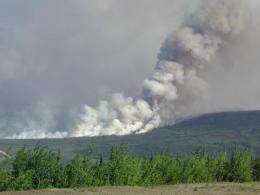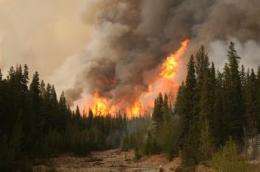Drying intensifying wildfires, carbon release ninefold, study finds

Drying of northern wetlands has led to much more severe peatland wildfires and nine times as much carbon released into the atmosphere, according to new research led by a University of Guelph professor.
The study, published today in Nature Communications, is the first to investigate the effect of drainage on carbon accumulation in northern peatlands and the vulnerability of that carbon to burning.
"Russia, Indonesia and Canada all have abundant peatlands, but they also have been hotspots for intense peat fires in the past decade," said Guelph professor Merritt Turetsky, who worked on the study with William Donahue of the Water Matters Society of Alberta and Brian Benscoter from Florida Atlantic University.
In pristine states, peatlands often resist fire because of their wet soils. "Our study shows that when disturbance lowers the water table, that resistance disappears and peat becomes very flammable and vulnerable to deep burning," she said.
Recently, destructive peat fires plagued the Moscow region. In the late 1990s, severe Indonesian fires in drained peatlands released carbon equivalent to 40 per cent of annual global fossil fuel emissions.
"Our results demonstrate the importance of cumulative impacts," Turetsky said.
Peatlands store vast amounts of carbon by pulling carbon dioxide out of the atmosphere. For millennia, they've accumulated plant debris — the remains of wood, moss, and other plants — and locked it up in layers of saturated peat more than five metres deep in places.

Northern peat covers large swaths of the landscape. Because about half of that peat consists of carbon, it is a globally important carbon pool.
But peatlands are also carbon sources, as this same debris fuels wildfires. "While fire is a widely recognized disturbance in upland forests, the impacts of fire on peatlands and their carbon storage have been largely overlooked," said Benscoter.
The majority of the world's peatlands are located in northern regions, and Canada is home to some of the largest on the planet.
"The extensive deposits of peat in Canada are an important natural resource, but one that is being disturbed more often, not only by wildfire but also by human activities," Turetsky said. Previous studies have documented the effects of land use practices and global warming on the ecology of peatlands. "But we wanted to examine how decades of lowered water table in peatlands might affect wildfire behaviour, and that required a very large experiment."
To determine those effects, the researchers used a unique outdoor laboratory. A large section of a boreal fen near Slave Lake, Alta., had been drained over 20 years ago in a wetland drainage project. A portion of the fen including drained and pristine plots burned in a wildfire in 2001 allowed for a natural experiment.
Earlier research had documented increases in tree growth and carbon storage after drainage. "But nobody had looked at the impacts of dewatering on fire intensity and associated carbon gains or losses," Donohue said.
The results were surprising, he said. Long-term drainage actually increased tree productivity and carbon storage in the fen soils. But the lower water table also changed wildfire conditions, and losses of soil carbon to burning in the drained areas increased ninefold.
"Even though the organic matter accumulation doubled over two decades after drainage, severe burning triggered the complete loss of this newly stored carbon, plus a further 450 years' worth of peat accumulation," Donahue said.
"Currently, peatlands are considered important global stores for carbon. But we've shown that human disturbance or climate-induced drying can switch peatlands from sinks to potentially huge sources of carbon, with losses associated with severe burning far outweighing long-term rates of sequestration."
Provided by University of Guelph














